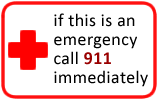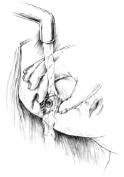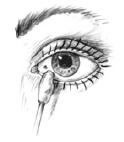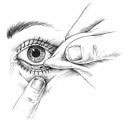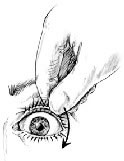Eye - Foreign Body
Eye - Foreign Body
Does this describe your child's symptoms? |
Click image for more info |
Definition
Causes
|
If not, see these topics
First Aid:First Aid Advice For Glass Fragments On The Eyelids
|
When to Call Your Doctor |
Call Your Doctor Now (night or day) If |
|
|
|
Call Your Doctor Within 24 Hours (between 9 am and 4 pm) If |
|
|
|
Call Your Doctor During Weekday Office Hours If |
|
|
|
Parent Care at Home If |
|
|
HOME CARE ADVICE FOR EYE FOREIGN BODY |
Reassurance:
The foreign body will always stay in the front part of the eye.
Some parents needlessly worry that the foreign body can get lost behind the eyeball.
This is impossible, since the space beyond the eyelids goes back ¼ inch (6 mm) and then stops (i.e., it's a dead end).
Treatment For Numerous Particles (such as dirt or sand):
Clean around the eye with a wet washcloth first.
Then have your child try to open and close the eye repeatedly while submerging that side of the face in a pan of water.
If your child is too young to cooperate with this, fill a glass or pitcher with warm tap water. Pour the water into the eye while holding your child face up. The eyelids must be held open during the irrigation and this usually requires the help of another person.
Treatment for a Particle in a Corner of the Eye:
Try to get it out with a moistened cotton swab, the corner of a moistened cloth, or a small piece of Scotch tape.
Treatment for a Particle Under the Lower Lid:
Pull the lower lid out by pulling down on the skin above the cheekbone.
Touch the particle with a moistened cotton swab.
If that doesn't work, try pouring water on the speck while holding the lid out.
Treatment for a Particle Under the Upper Lid:
If the particle can't be seen, it's probably under the upper lid, the most common hiding place.
Try having your child open and close the eye several times while it is submerged in a pan or bowl of water. If you have an eye cup, use it.
If this fails, pull the upper lid out and draw it over the lower lid while the eye is closed. When the eye is opened, the lower lid may sweep the particle out from under the upper lid.
Contacts: Children with contact lenses need to switch to glasses temporarily (Reason: to prevent damage to the cornea).
Expected Course: The discomfort, redness and excessive tearing usually pass 1 to 2 hours after the foreign body is removed.
Call Your Doctor If:
This approach does not remove all the foreign material from the eye (i.e., if the sensation of "grittiness" or pain persists)
Vision does not return to normal after the eye has been washed out
Foreign object has been removed, but tearing and blinking persist
Your child becomes worse
And remember, contact your doctor if your child develops any of the "Call Your Doctor" symptoms.
Updated:
March 22, 2017
